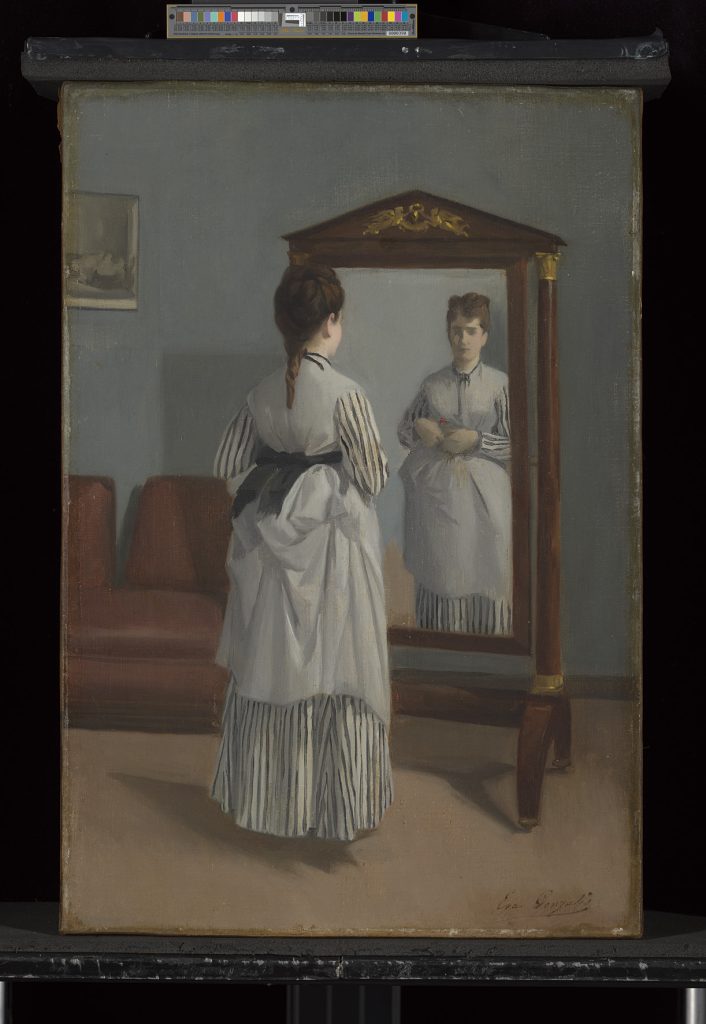The National Gallery has introduced one of the most notable French Impressionist painters into their collection. It’s not Monet nor Manet, but a woman, making her only the 20th female artist in the collection to date.
The London-based institution, has acquired their first ever painting from Eva Gonzalès, a 19th-century French artist and the only formal pupil of Édouard Manet, a fellow Parisian painter.
British art collections, including Tate, are trying to redress the imbalance between male and female artists, with the National Gallery holding only 27 works by female artists in their 2,300-strong collection.

Credit: © The National Gallery, London
Christopher Riopelle, the Neil Westreich curator of post-1800 paintings at the National Gallery, says: “We are excited that it has come to the National Gallery. The world of Impressionist studies, and of women artists studies is, if anything, even more excited.”
La Psyché, translated as The Full-length Mirror, was painted between 1869 and 1870 and depicts a woman standing in front of a mirror.
The painting was bought with the help of three female legacy gifters from a private British collection, where it has been unseen for more than half a century. It will now be on display in the gallery’s main collection room.
Gonzalès, born in 1849, received professional art training at the age of 16, becoming Manet’s pupil and model four years later.
Manet painted Gonzalès in front of an easel and the artwork, with the same name as the subject, was exhibited in the 2022 exhibition at the gallery, Discover Manet & Eva Gonzalès.
But despite her prominence in the Impressionist art movement, it has taken two centuries for the gallery to acquire a painting from her since it opened in 1824.
Sarah Herring, associate curator of post-1800 paintings and one of the curator’s of the joint exhibition, said that Gonzalès’s reputation as Manet’s muse often overshadowed her own work.
She said: “Since Manet’s Eva Gonzalès (1917), Gonzalès has been represented in the collection by an extraordinary yet complicated portrait. Yet despite the association with great artists of the past, the image is one of part painter, part society beauty.”
Herring added: “It was imperative to redress the balance by acquiring a painting by her, to be able to show her own work, particularly as the painting displayed on the easel in Manet’s portrait is… nothing to do with her own painting at the time.”
Other female artists in the collection include Paula Rego, Berthe Merisot, and Rachel Ruysch.
The gallery, which covers western European painting from the 13th to 20th century, said it struggled to acquire female paintings during the period when women were denied opportunities to practise painting and restricted in their subjects.
They also said, at the time of opening, collectors prioritised acquiring well-known artists, of which almost all were men.
The Society of Women artists, which promotes fine art created by women, said: “It is always tempting to bemoan how few women artists are represented in the world’s most important public collections but to do so generates negative energy that does little to advance our cause.
“Every step that can be made to draw attention to women artists, past and present, is a step toward righting the balance. We must applaud the National Gallery’s retrospective recognition of the fine Impressionist painter Eva Gonzalès.
“Her fresh and beautiful work is a belated but significant addition to their collection.”
Feature image credit: Nicolas Lysandrou on Unsplash
